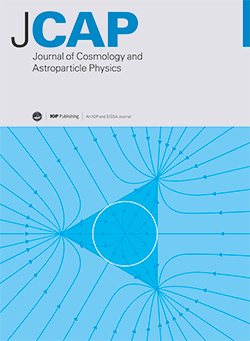Regular black hole models in the transition from baryonic matter to quark matter
IF 5.3
2区 物理与天体物理
Q1 ASTRONOMY & ASTROPHYSICS
Journal of Cosmology and Astroparticle Physics
Pub Date : 2025-06-24
DOI:10.1088/1475-7516/2025/06/051
引用次数: 0
Abstract
In this paper, we investigate gravitational collapse scenarios involving baryonic matter transitioning into quark-gluon plasma under extreme astrophysical conditions, focusing on their implications for the formation of regular black holes. Standard gravitational collapse models inevitably predict central singularities, highlighting the limitations of classical general relativity in extreme density regimes. By introducing a physically motivated, inhomogeneous transition rate between baryonic and quark matter, we demonstrate analytically and numerically that it is possible to construct regular black hole solutions featuring a nonsingular de Sitter-like core. We further analyze the observable consequences of these models, particularly emphasizing modifications to the black hole shadow radius, which provide direct observational constraints accessible through Event Horizon Telescope (EHT) measurements.重子物质向夸克物质转变过程中的规则黑洞模型
在本文中,我们研究了在极端天体物理条件下重子物质转变为夸克-胶子等离子体的引力坍缩情景,重点研究了它们对规则黑洞形成的影响。标准引力坍缩模型不可避免地预测中心奇点,突出了经典广义相对论在极端密度状态下的局限性。通过引入重子和夸克物质之间的物理驱动的非均匀跃迁速率,我们从解析和数值上证明了构造具有非奇异德西特类核心的规则黑洞解是可能的。我们进一步分析了这些模型的可观测结果,特别强调了黑洞阴影半径的修改,这提供了通过事件视界望远镜(EHT)测量可获得的直接观测约束。
本文章由计算机程序翻译,如有差异,请以英文原文为准。
求助全文
约1分钟内获得全文
求助全文
来源期刊

Journal of Cosmology and Astroparticle Physics
地学天文-天文与天体物理
CiteScore
10.20
自引率
23.40%
发文量
632
审稿时长
1 months
期刊介绍:
Journal of Cosmology and Astroparticle Physics (JCAP) encompasses theoretical, observational and experimental areas as well as computation and simulation. The journal covers the latest developments in the theory of all fundamental interactions and their cosmological implications (e.g. M-theory and cosmology, brane cosmology). JCAP''s coverage also includes topics such as formation, dynamics and clustering of galaxies, pre-galactic star formation, x-ray astronomy, radio astronomy, gravitational lensing, active galactic nuclei, intergalactic and interstellar matter.
 求助内容:
求助内容: 应助结果提醒方式:
应助结果提醒方式:


